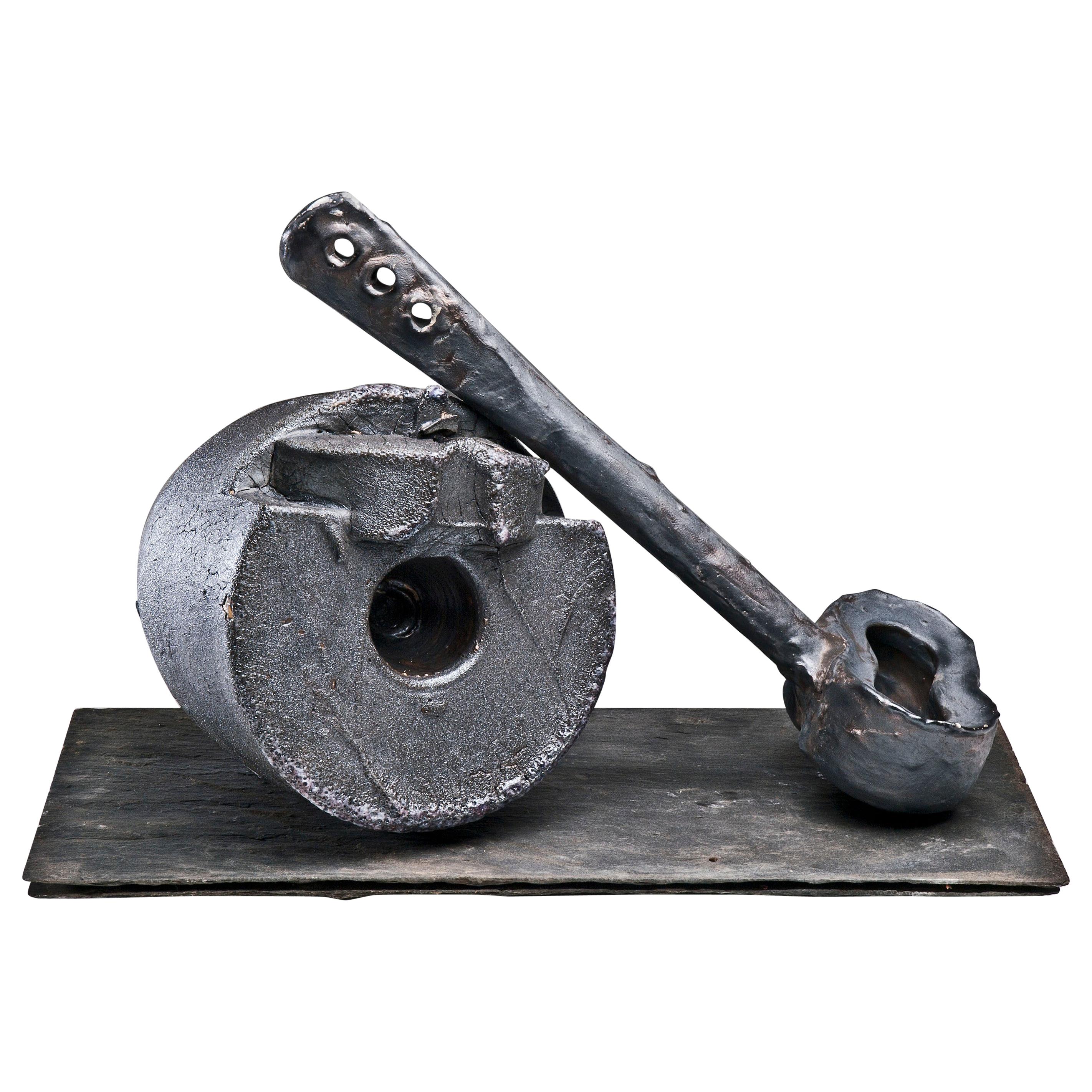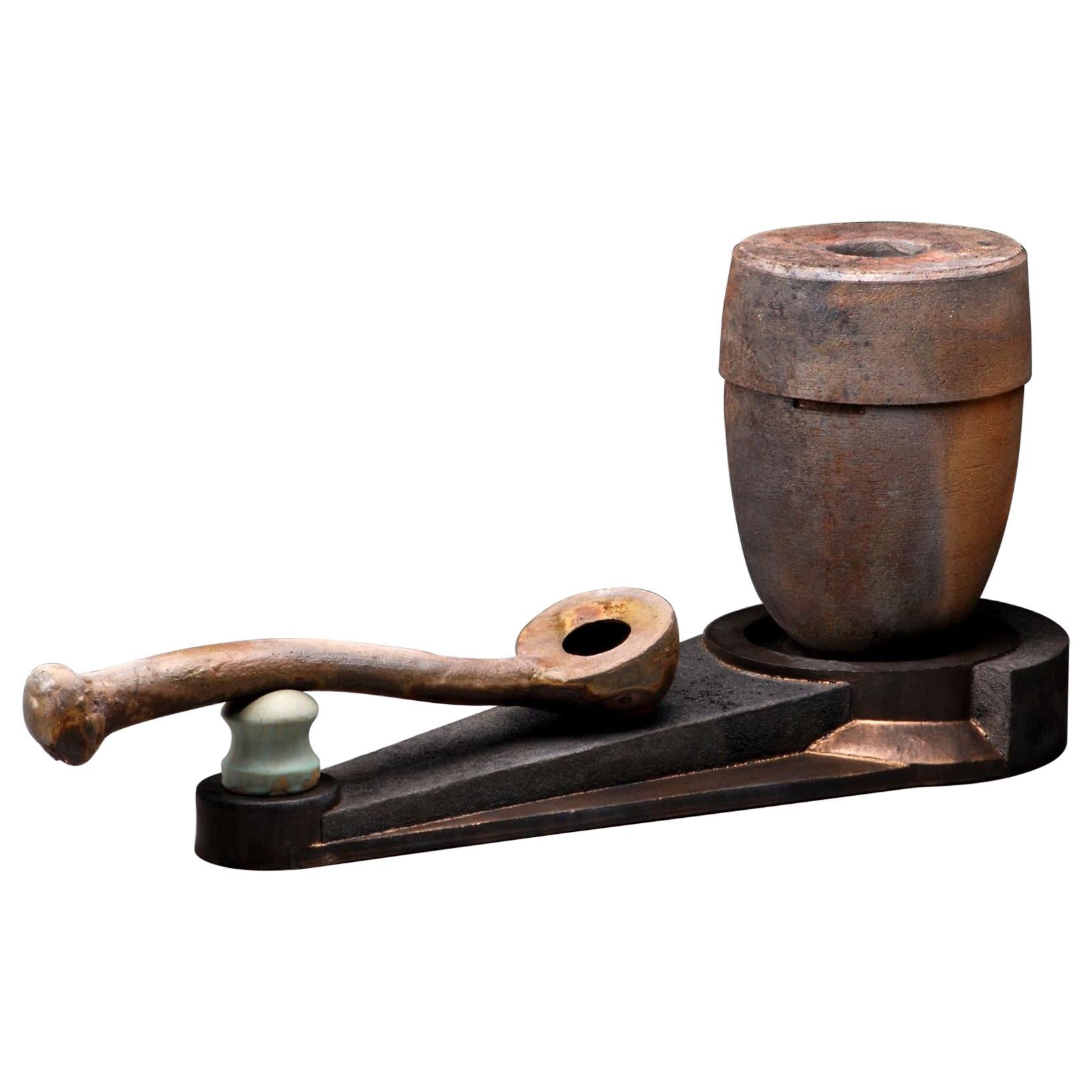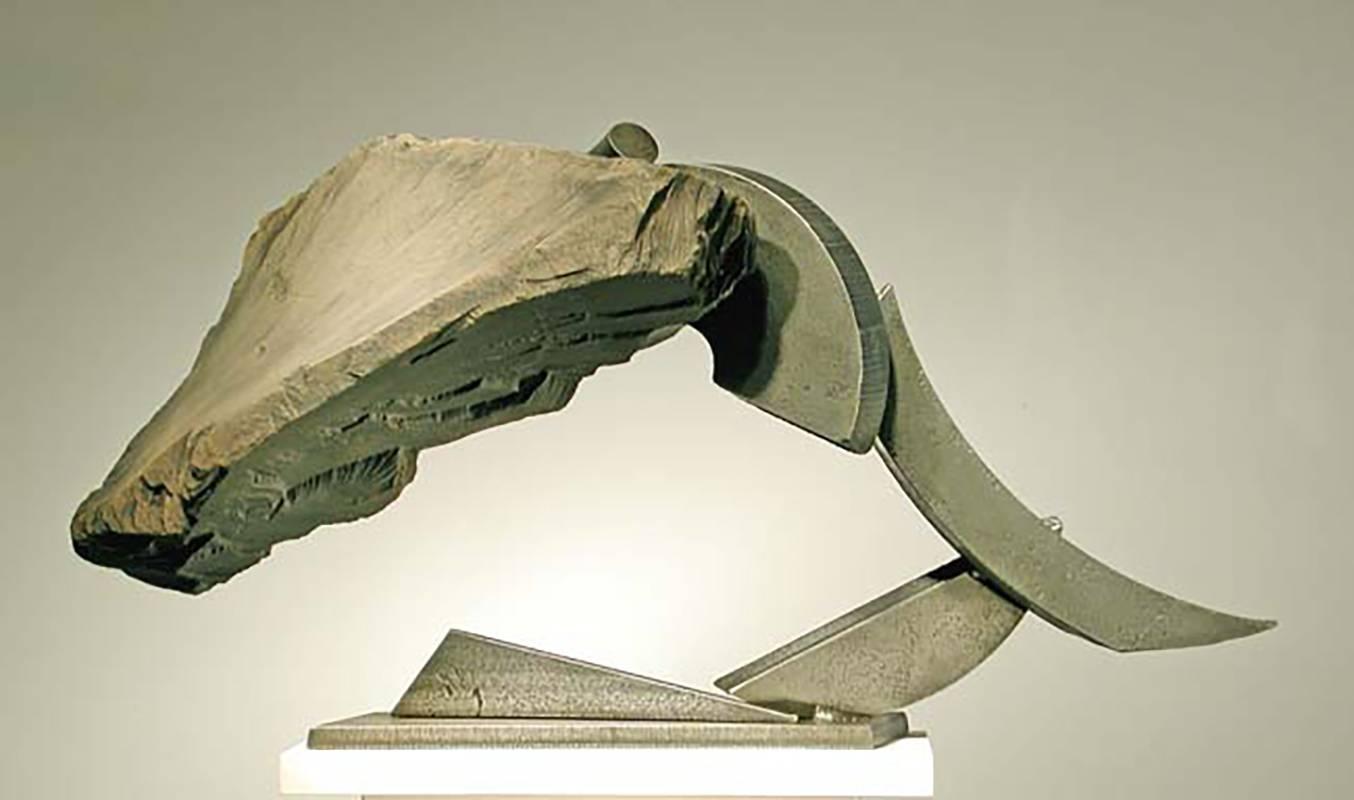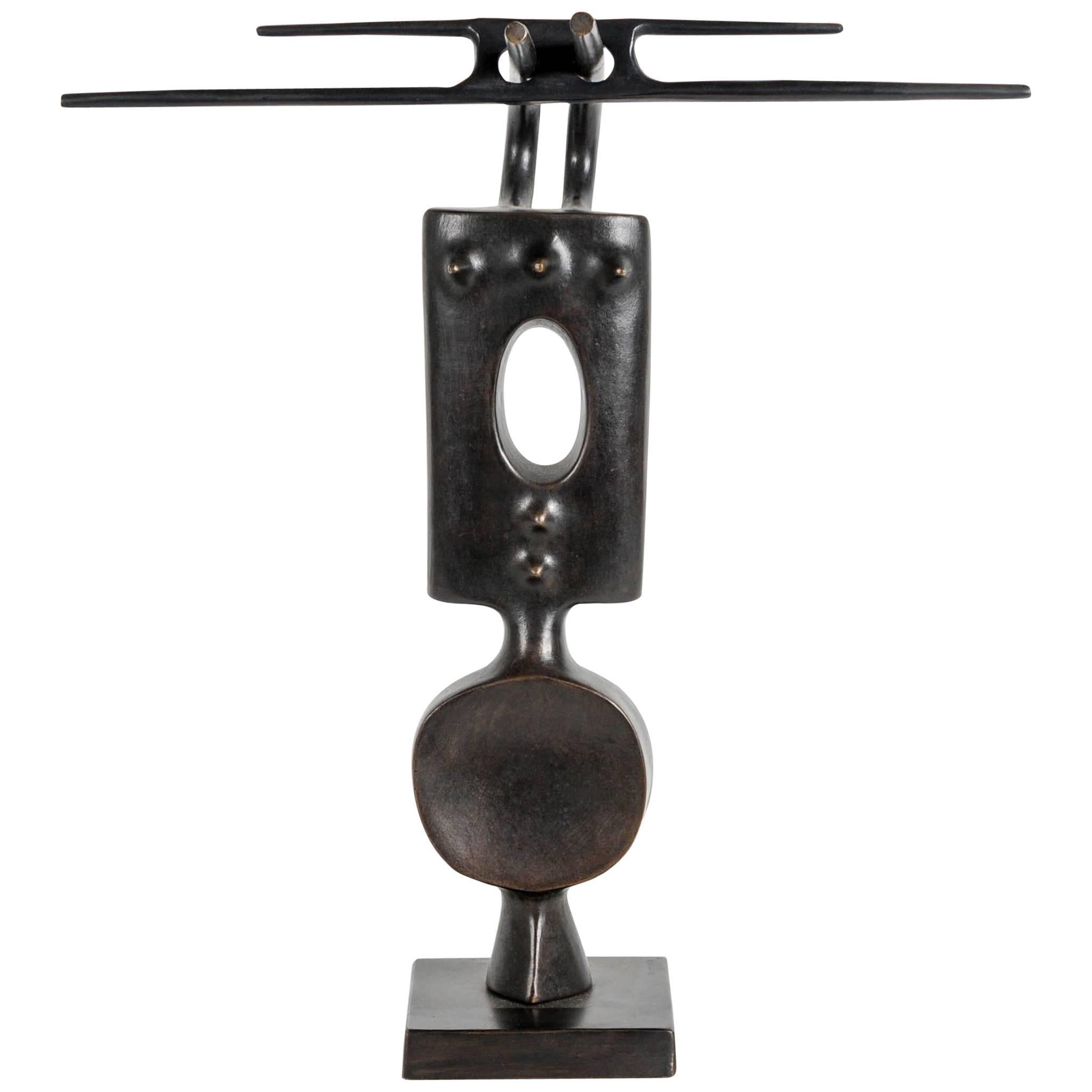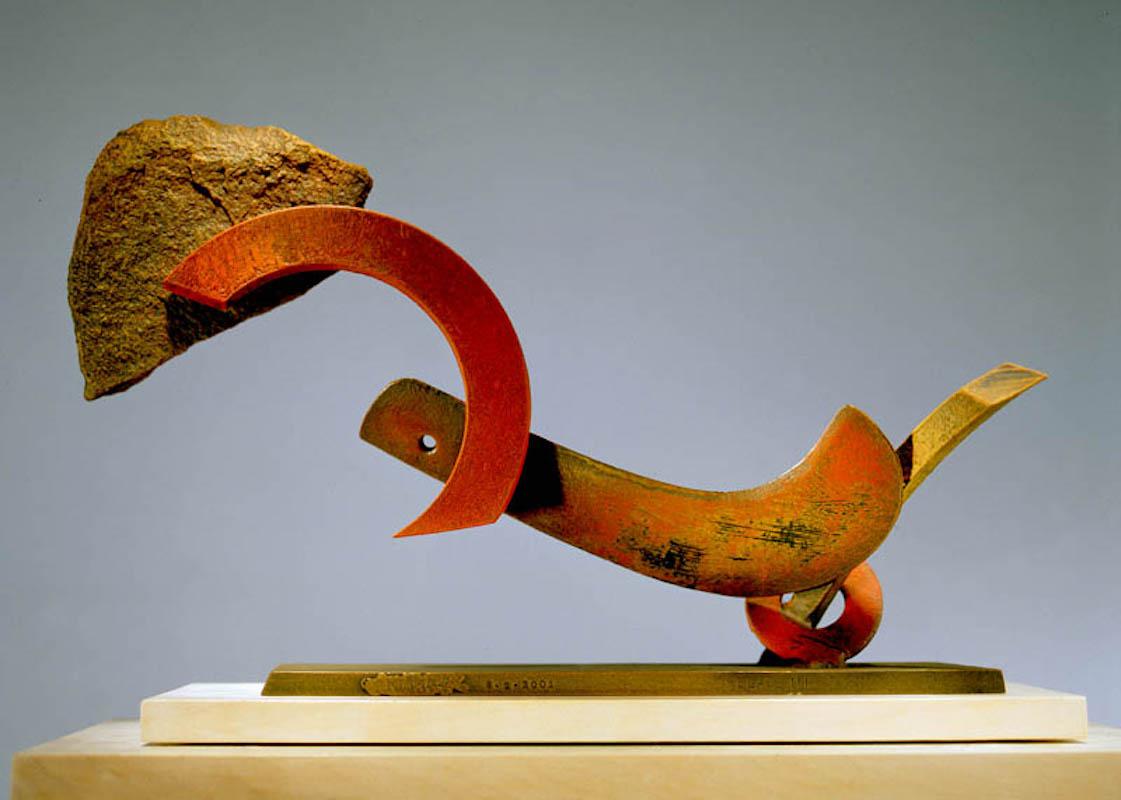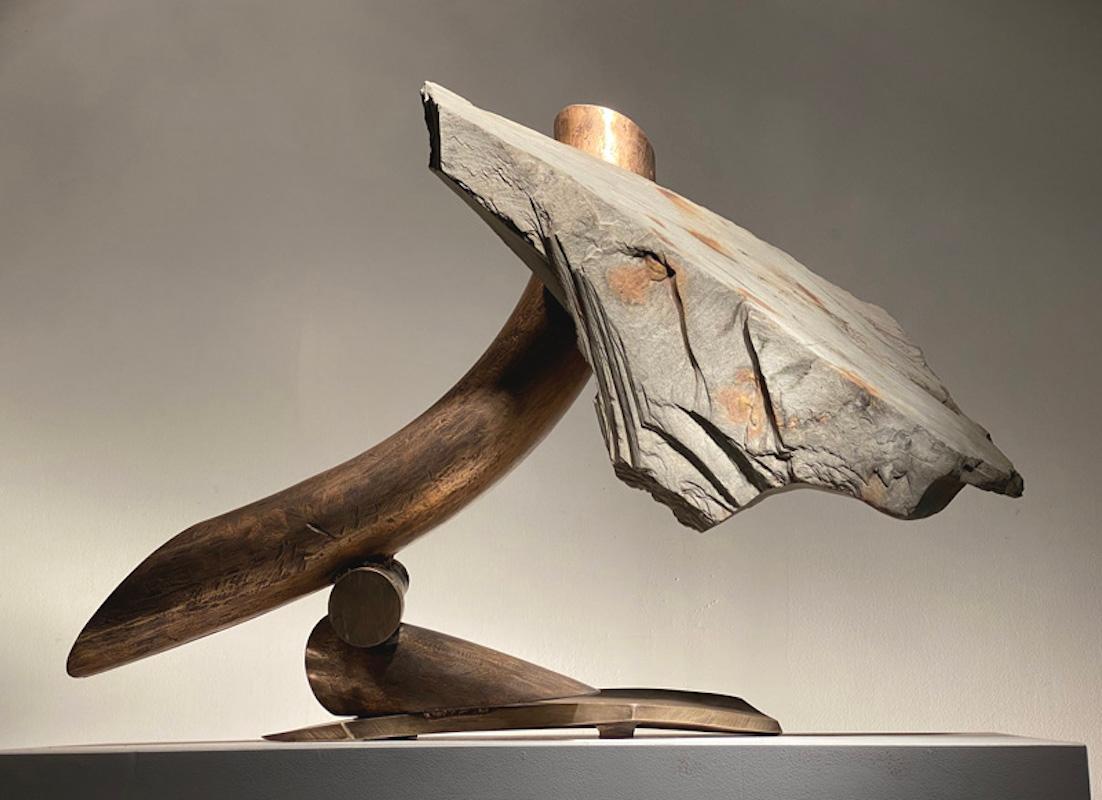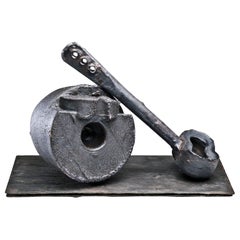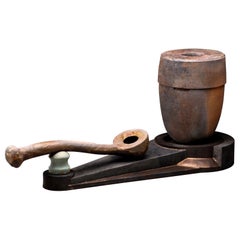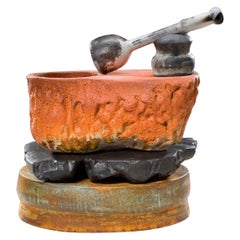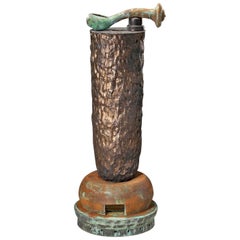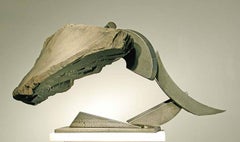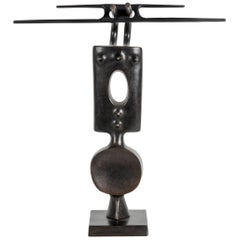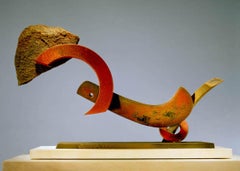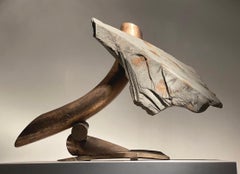Items Similar to Richard Hirsch and Ken Baskin Ladle Presentation Sculpture, 2011
Want more images or videos?
Request additional images or videos from the seller
1 of 9
Richard Hirsch and Ken Baskin Ladle Presentation Sculpture, 2011
$7,500
£5,688.27
€6,533.21
CA$10,744.79
A$11,829.22
CHF 6,045.94
MX$141,184.91
NOK 76,977.71
SEK 72,033.98
DKK 48,799.25
About the Item
Contemporary American ceramic artists Richard Hirsch and Ken Baskin Ladle Presentation Sculpture was created in 2011. This piece is made of soda fired stoneware, saggar fired brick and steel. In the book "With Fire: Richard Hirsch, A Life Between Chance and Design" written by Scott Meyer, Ken Baskin said; "Working collaboratively is based upon a spirit of dedication and generosity, excellent communication, similar levels of ability and an alignment of passion and vision. Most importantly, the group must have mutual trust and respect. Without question, we all hold each other in the highest esteem. I have the utmost respect for everyone involved in The Crucible Project." This sculpture is signed by both artists and ships directly from the Crucible Show inventory located in Montevello, Al.
(Literature: "With Fire: Richard Hirsch, A Life Between Chance and Design", Scott Meyer (Author), RIT Cary Graphic Arts Press 2012 - "Outside In, Collaboration" pgs. 106 - 121 / "Ladle Presentation" pictured on pg. 119)
Richard Hirsch Brief Bio:
In the field of contemporary ceramic, Rick Hirsch has earned an international reputation. He has achieved this recognition by engaging in numerous diversified professional activities. Through efforts in university teaching, exhibits, writing, lecturing and researching he has risen to worldwide prominence.
In 1975, Hirsch co-authored a book entitled Raku, published by Watson-Guptill. This was the first comprehensive text to address the new innovations developing in the west that were transforming traditional Japanese Raku. Also, in the same year, Hirsch became a founding faculty member of The Program in Artistry at Boston University. Currently, Hirsch is a Professor Emeritus at The School for American Crafts which is a part of Rochester Institute of Technology in Rochester, NY. His university teaching career now spans well over four decades.
Repeatedly, Hirsch has participated in several milestone exhibitions and publications. Significant shows include; The Evolution of American Art in Craft Media Since 1945; Echoes: Historical References in Contemporary Ceramics; American Ceramics Now; Raku: Origins, Impact and Contemporary Expression; and Convergences: The Presence of the Past in Contemporary American Ceramics.
Frequently his work appears in book and magazine publications, such as; Overseas Contemporary Ceramic Art Classics by Baiming, China; Raku Investigations into Fire by David Jones, England; The History of American Ceramics from 1607 to the Present by Elaine Levin, New York; World Contemporary Ceramics by Baiming, China; and Firing, Philosophies within Contemporary Ceramic Practice by David Jones, England.
Several museums have included his work for their permanent collections. These include; The Carnegie Museum of Art, Pittsburgh; The Renwick Gallery, Smithsonian Institute, Washington DC; The High Museum of Art, Atlanta; The Everson Museum of Art, Syracuse; The Nelson-Atkins Museum of Art, Kansas City, Missouri; The Taipei County Yinko Ceramics Museum, Taipei, Taiwan; and the George R. Gardiner Museum of Ceramic Art, Toronto, Canada.
In 1984, Hirsch was elected as a permanent member of The International Ceramics Academy, a worldwide organization headquartered in Geneva, Switzerland. A recipient of a William J. Fulbright Research Scholar Award in 2002, Hirsch has also received several Individual Artists Grants. Most recently he was honored by The Rochester Institute of Technology, with the Board of Trustees' Outstanding Scholarship Award. Recently Hirsch collaborated with Dr. Scott Meyer on his biography, the book is entitled With Fire: Richard Hirsch and is published by The Cary Graphic Arts Press at RIT, ISBN-13: 978-1-933360-97-3.
Amid the ever-shifting sands of change and new trends that is prevalent in contemporary ceramics, Richard Hirsch has maintained his steadfast personal aesthetic and continues to make a significant contribution to his field.
Ken Baskin Brief Bio:
Kenneth Baskin received his BFA from College for Creative Studies in Detroit, Michigan and earned his MFA from University of South Carolina. Presently he holds the position of Associate Professor of Art/Ceramics at McNeese State University in Lake Charles, Louisiana.
In 2007 Baskin was honored as one of the recipients of one of the National Council on Education in the Ceramic Arts (NCECA) Emerging Artist Awards. Recently he was honored by being selected for a solo exhibition of his ceramic sculptures at the Taipei County Yingge Ceramics Museum, Taipei, Taiwan; in conjunction with this exhibition he was also invited as a visiting artist, workshop instructor and lecturer at: Tainan National University of the Arts in Tainan, Taiwan and National Taiwan University of the Arts in Taipei. Baskin’s work has also been included in numerous group and solo exhibitions both nationally and internationally. Baskin’s creative research was the topic for an essay titled “20th Century Artifact Series” that was published and featured on the cover of Ceramics Monthly Magazine, November 2009 Issue.
- Creator:Richard A. Hirsch (Artist),Ken Baskin (Artist)
- Dimensions:Height: 19 in (48.26 cm)Width: 15 in (38.1 cm)Depth: 12 in (30.48 cm)
- Style:Modern (In the Style Of)
- Materials and Techniques:
- Place of Origin:
- Period:
- Date of Manufacture:2011
- Production Type:New & Custom(One of a Kind)
- Estimated Production Time:Available Now
- Condition:Wear consistent with age and use.
- Seller Location:New York, NY
- Reference Number:Seller: RHKB 0011stDibs: LU863322996472
Additional sculptures and fine art in this collection are available, please contact the Seller for more information.
About the Seller
5.0
Vetted Professional Seller
Every seller passes strict standards for authenticity and reliability
Established in 2005
1stDibs seller since 2009
119 sales on 1stDibs
Typical response time: 2 hours
Associations
20th Century Specialists
- ShippingRetrieving quote...Shipping from: Montevello, AL
- Return Policy
Authenticity Guarantee
In the unlikely event there’s an issue with an item’s authenticity, contact us within 1 year for a full refund. DetailsMoney-Back Guarantee
If your item is not as described, is damaged in transit, or does not arrive, contact us within 7 days for a full refund. Details24-Hour Cancellation
You have a 24-hour grace period in which to reconsider your purchase, with no questions asked.Vetted Professional Sellers
Our world-class sellers must adhere to strict standards for service and quality, maintaining the integrity of our listings.Price-Match Guarantee
If you find that a seller listed the same item for a lower price elsewhere, we’ll match it.Trusted Global Delivery
Our best-in-class carrier network provides specialized shipping options worldwide, including custom delivery.More From This Seller
View AllRichard Hirsch, Scott Meyer & Virginia Scotchie Crucible Assembly Sculpture
By Scott Meyer, Virginia Scotchie, Richard A. Hirsch
Located in New York, NY
Contemporary American ceramic artists Richard Hirsch, Scott Meyer and Virginia Scotchie's Crucible Assembly Sculpture was created in 2012. This piece is ma...
Category
21st Century and Contemporary American Modern Abstract Sculptures
Materials
Slate
Richard Hirsch, Scott Meyer and Ken Baskin Crucible Project Sculpture, 2013
By Ken Baskin, Scott Meyer, Richard A. Hirsch
Located in New York, NY
Contemporary American ceramic artists Richard Hirsch, Scott Meyer and Ken Baskin's collaborative Crucible Project Sculpture was created in 2013 and is wood...
Category
21st Century and Contemporary American Modern Abstract Sculptures
Materials
Ceramic, Stoneware
Richard Hirsch Ceramic Mortar and Pestle Sculpture, 2010
By Richard A. Hirsch
Located in New York, NY
Contemporary American ceramic artist Richard Hirsch's Mortar and Pestle Sculpture was assembled in 2010. It's wheel thrown and hand built clay, lowfired slips, black glaze, raku pati...
Category
21st Century and Contemporary American Modern Abstract Sculptures
Materials
Ceramic
Richard Hirsch Glazed Ceramic Crucible Sculpture #25, 2011
By Richard A. Hirsch
Located in New York, NY
Contemporary American ceramic artist Richard Hirsch Ceramic Crucible Sculpture #25 was made in 2011. It's wheel thrown and hand built clay, soda fire...
Category
21st Century and Contemporary American Modern Abstract Sculptures
Materials
Ceramic, Stoneware
Richard Hirsch Ceramic Mortar and Pestle Sculpture #30, 2009
By Richard A. Hirsch
Located in New York, NY
Contemporary American ceramic artist Richard Hirsch's Mortar and Pestle Sculpture #30 was assembled in 2009. It's wheel thrown and hand built clay, slips and glazes with raku patinas. The following is an excerpt from the book "With Fire: Richard Hirsch, A Life Between Chance and Design" written by Scott Meyer; "The glass "masher" is lightly sand-blasted, suggesting opacity but yielding subtle light penetration, the perfect foil for Hirsch’s heavy clay concavities. Conceptually, Hirsch enjoys the compatibility of the two heat-driven materials, and the alchemical issues with shared chemistry seems right for themes involving vessels and raw geologic age." This four piece sculpture is signed and dated by the artist. It will ship directly from the artist’s studio in Rochester, NY.
(Literature: "With Fire: Richard Hirsch, A Life Between Chance and Design", Scott Meyer (Author), RIT Cary Graphic Arts Press 2012 - "Mortars and Pestles" pgs. 57 - 60. The Ceramic Mortar and Pestle...
Category
21st Century and Contemporary American Modern Abstract Sculptures
Materials
Ceramic
Richard Hirsch and Michael Rogers Figure Sculpture, 2007
By Richard A. Hirsch , Michael Rogers
Located in New York, NY
Contemporary American ceramic artist Richard Hirsch and glass artist Michael Rogers' Figure Sculpture was created in 2007. This sculpture is comprised of a cast glass head...
Category
21st Century and Contemporary American Modern Abstract Sculptures
Materials
Ceramic, Blown Glass, Glass
You May Also Like
John Van Alstine - FLECHE, Sculpture 2005
By John Van Alstine
Located in Stamford, CT
Slate, Steel
Stone and metal, usually granite or slate and found object steel are central in my sculpture. The interaction of these materials is a major focus. On the most basic lev...
Category
Early 2000s Abstract Abstract Sculptures
Materials
Stone, Slate, Steel, Cut Steel, Stainless Steel
Bronze Sculpture by Victor Roman
By Victor Roman
Located in Bois-Colombes, FR
Bronze sculpture by Victor Roman. Signed and numbered 2/8.
Category
Vintage 1970s French Abstract Sculptures
Materials
Bronze
John Van Alstine, BLADE III, Sculpture 2001
By John Van Alstine
Located in Stamford, CT
BLADE III
Enamel on granite and steel
13" (height) x 19" (width) x 6" (depth)
Stone and metal, usually granite or slate, and found object steel are central in my sculpture. The inte...
Category
21st Century and Contemporary Contemporary Abstract Sculptures
Materials
Granite, Enamel, Steel
John Van Alstine, Implement Stout Handle II, Sculpture 2020
By John Van Alstine
Located in Stamford, CT
Implement Stout Handle II
Bronze and slate
24" (height) x 33" (width) x 10" (depth)
Stone and metal, usually granite or slate, and found object steel are central in my sculpture. Th...
Category
21st Century and Contemporary Contemporary Abstract Sculptures
Materials
Granite, Steel
Claude Viseux, Abstract Sculpture, Late 20th Century, Steel
By Claude Viseux
Located in SAINT-SEVER, FR
Claude Viseux est un peintre, sculpteur et graveur aquafortiste et lithographe français né le 3 juillet 1927 à Champagne-sur-Oise et mort le 9 novembre 2008 à Anglet.
'est dans les années 1959-1960 que la sculpture de Claude Viseux, qualifiée de « protéiforme, onirique, fantastique » — ami de Max Ernst, Man Ray, Francis Ponge et Henri Michaux, il ne désavoue pas une parenté avec le Surréalisme9 — se substitue à la peinture, ses premières réalisations étant les objets trouvés en bord de mer qu'il pétrifie dans la cire10 d'une part, les empreintes de pierres et d'algues coulées en bronze d'autre part.
En 1960, il signe le Manifeste des 121 titré « Déclaration sur le droit à l’insoumission dans la guerre d’Algérie ».
En 1961, ses expérimentations s'orientent vers les corps organiques, notamment avec sa série Ostéales constituée d'assemblages d'os fossilisés qu'il patine ou au contraire décape, qu'il visse, scie, assemble et plastifie. Les Concrétudes ou Coulées directes qui suivent en 1961-1962 sont obtenues à partir de coulées de métal en fusion dans le sable, générant des reliefs qu'il soude sur des plaques d'acier. Il va cependant adopter rapidement l'acier inoxydable — qu'il est avec Pol Bury parmi les premiers à employer en sculpture — comme matériau de prédilection. « Il assemble divers rebus industriels — tuyaux, écrous, boulons, cuves… — pour créer des sculptures à mi-chemin du mécanique et du biologique » restitue ainsi Sophie Serra11. Claude Viseux, qui fréquente alors Jean Tinguely, Piotr Kowalski, Michel Guino, Takis et César, confirme : « Ma récupération de l'élément industriel s'élargit vers les aciers spéciaux, avec un essai de vocabulaire formel : des barres, des profilés, des sphères, des rotules, des fonds de cuves, des chambres à combustion de Boeing, des tubulures, des soupapes de navire »9.
« L'artiste entre au cœur de la réalité industrielle, prospecte dans les chaînes de montage de Renault et rôde dans les terrains vaques autour des usines », restitue donc l'encyclopédie Les Muses : « il récupère ferrailles, pièces détachées, débris de voitures, vieux châssis, toute une série d'éléments devenus inutiles. Ils les assemblent, tels quels, sans les modifier. Des créatures agressives ou pathétiques vont surgir de ce combat physique et dialectique que l'artiste livre avec la matière et entrer dans le domaine d'une poétique étrange, surnaturelle5 ». Dans les années 1967-1970, Les « structures actives » en acier inoxydable procèdent ainsi de la production industrielle de série. Elles se répartissent en familles de formes combinatoires composées par addition, soustraction, multiplication, division. Il confirme : « le monde industriel est ma nature, mon bouillon de culture, où je cherche des corps, des familles de corps, des genres, des espèces, dans un aller-retour de l'artificiel au naturel pour confondre les règnes, pour en inventer d'autres selon une géométrie organique qui féconde les différents types de structures, qui aménage la forme concernée par la forme à venir »9. En 1968, Claude Viseux s'installe à la villa Baudran à Arcueil, atelier qu'il conservera jusqu'en 1992.
Si des corps imaginaires naissent ainsi des pièces mécaniques que Claude Viseux emprunte à l'automobile, à l'avion et au bateau, en 1972, « la symétrie de ces formes pures en inox », constate Lydia Harambourg, « l'amène à s'interroger sur la notion d'équilibre instable »12. Ses Instables sont de la sorte exposés à la Biennale de Venise en 1972 où, rappelle encore Lydia Harambourg, une salle entière est consacrée « aux dessins qui reprennent son vocabulaire mécanique identitaire de sphères, toupies, hélices, anneaux, astrolabes et balanciers »12. Les Instables sont de même, en 1973, présentés à la galerie Le Point cardinal à Paris où Claude Viseux avait déjà exposé en 1968 avec Henri Michaux et Joaquin Ferrer...
Category
Vintage 1960s French Abstract Sculptures
Materials
Stainless Steel
$1,808 Sale Price
20% Off
Bronze Sculpture by Joel Perlman
Located in Dallas, TX
Though small in scale this 1982 bronze by Joel Perlman (b. 1943) is big in visual impact. A successful New York City sculptor for the last 30 years his work is in the permanent colle...
Category
Vintage 1980s American Abstract Sculptures
Materials
Bronze
More Ways To Browse
Taiwan Ceramics
Artifacts 20th Century
20th Century Artifacts
Abstract Stoneware Ceramic Vase Sculpture
Organic Marble Sculpture
Lena Bergstrom
Metal Sculpture Spain
Purple Lucite
Wood Root Sculptures
Artifacts Furniture
Rectangular Sculpture
Tabletop Abstract Sculptures
Torch Cut Sculpture
Modern Shapes Sculpture
Ceramic Flower Sculpture
Modern Abstract Faces
Abstract Alabaster Sculpture
Abstract Shell Sculpture
